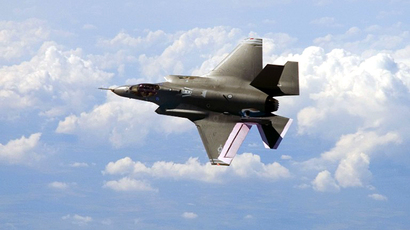Air Force repaints its trucks because of F-35s

Plagued with chronic cost overruns and delayed deliveries, the Pentagon’s F-35 Joint Strike Fighter has yet another issue threatening the plane’s safety record: the dark-green, heat-absorbing trucks used to refuel the jet need a new paint job.
Luke Air Force Base in Arizona recently announced that, based on the fifth-generation fighter’s requirement that fuel be under a certain temperature for safe takeoff and vertical landing, the dark-colored trucks that carry the jet’s fuel must be painted with a reflective coat as to avoid absorbing heat from the sun, thus keeping fuel temperature at an acceptable level.
"We painted the refuelers white to reduce the temperature of fuel being delivered to the F-35 Lightning II joint strike fighter," said Senior Airman Jacob Hartman, a 56th Logistics Readiness Squadron (LRS) fuels distribution operator. "The F-35 has a fuel temperature threshold and may not function properly if the fuel temperature is too high, so after collaborating with other bases and receiving waiver approval from (the Air Education Training Command), we painted the tanks white."
Luke AFB picked up on the idea from Edwards Air Force Base in California, according to the report. Officials hope a new paint job to the fuel trucks will head off another round of costly delays for what some have dubbed“the jet that ate the Pentagon.”
"It ensures the F-35 is able to meet its sortie requirements," said Chief Master Sgt. Ralph Resch, the 56th LRS fuels manager. "We are taking proactive measures to mitigate any possible aircraft shutdowns due to high fuel temperatures in the future."

Temperatures can hit as high as 110 degrees Fahrenheit in the Arizona desert where Luke AFB is located. Repainting the fuel tanks with a white solar polyurethane enamel is a first step in the process of maintaining cooler fuel temperatures, Resch said.
"This is the short-term goal to cool the fuel for the F-35; however, the long-term fix is to have parking shades for the refuelers," Resch said.
Yet, Luke AFB was told it is not necessarily the color of the paint that reflects the heat.
"The painting process is a two-part process, and the second part is the reflective process," said Master Sgt. Joseph Maurin, a 56th LRS fuels distribution officer. "The painter said it did not have to be a white color, so we are going to send one of the four vehicles to get painted green, if possible. We will then compare temperatures between the green and white trucks."
The 56th LRS will paint a handful of their refueling trucks at a cost of $3,900 each.
The revamped fuel trucks make up the latest, if comparatively underwhelming, chapter in the ongoing saga of the world’s most expensive aircraft.
The all-in-one plane, designed for a host of potential missions, is to have similar variants for the US Air Force, Navy, and Marine Corps. Just this month, the F-35C Joint Strike Fighter, the Navy’s version, finally made its first-ever recorded landing on an aircraft carrier.
The Lockheed Martin fighter jet’s price tag is estimated to end up costing US taxpayers more than $1 trillion, factoring in maintenance expenses. Though, the Pentagon said in August 2013 that the program’s estimated cost was “slashed” to a trim $857 billion.
Critics of the plane’s many functions say it’s too loaded down to be any more capable than the older, less-expensive F-16 fighter jet, which the F-35 is to replace along with F/A-18s, and A-10s.
In July, the US Defense Department grounded its entire fleet of aircraft for engine inspections after an F-35 caught fire as the pilot attempted to take off at a Florida air base.
Nevertheless, US officials including Defense Dept. Sec. Chuck Hagel stood behind the expensive program that some call “too big to fail” and that may be outdated by the time it finally materializes.

“Issues” aside, Hagel said, the F-35 still represents "the future for our fighter aircraft.”
Earlier in the year, in March, the US Government Accountability Office found that persistent software problems could delay the program for more than a year.
The auditors questioned whether the US could still afford the 2,457 planes that are slated for purchase. They could cost $400 billion – a 68 percent increase over original projections in 2001 – and keeping the program on schedule for 2037 could cost $12.6 billion per year.
Despite its fantastic price tag, the F-35 Joint Strike Fighter program has even failed to generate the number of jobs its proponents had originally promised to Congress.
In January, the Center for International Policy said Lockheed had “greatly exaggerated” its claim that the F-35 program will sustain 125,000 American jobs in 46 US states in an effort to win support for the program.
In addition to the US, Lockheed Martin is making F-35 versions for Australia, Britain, Canada, Denmark, Italy, the Netherlands, Norway, and Turkey, while Israel, Japan, and South Korea have placed orders for the fighter jet.














